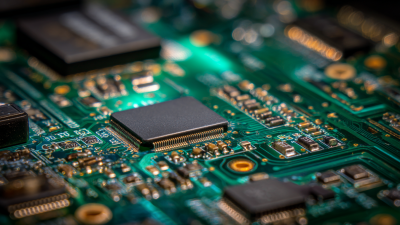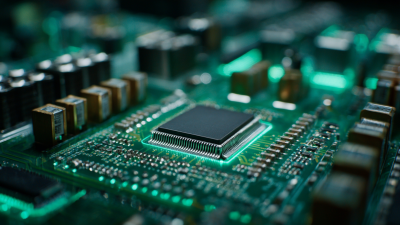Understanding Printed PCBs: How Industry Innovations Drive Performance and Efficiency in Electronics
The evolution of printed PCBs (Printed Circuit Boards) has revolutionized the electronics industry, paving the way for enhanced performance, efficiency, and innovation. As the backbone of modern electronic devices, printed PCBs are pivotal in ensuring that complex circuits are not only compact but also reliable and cost-effective. With advancements in materials, design methodologies, and manufacturing processes, these innovations are enabling engineers to push the limits of electronic capabilities, catering to the ever-growing demands of consumers and industries alike.

In this discussion, we will explore the top ten industry innovations that are driving the performance and efficiency of printed PCBs. These innovations range from the adoption of advanced substrates to the integration of smart technologies, showcasing how the field constantly adapts to meet the challenges of miniaturization and increased functionality. By examining these key developments, we will gain insights into how printed PCBs continue to shape the future of electronics and what this means for upcoming technology trends. This exploration not only highlights the technical aspects but also emphasizes the importance of printed PCBs as a fundamental component in the quest for technological advancement.
The Evolution of Printed Circuit Boards: Key Innovations Shaping Modern Electronics
The evolution of printed circuit boards (PCBs) is pivotal in shaping modern electronics, powered by relentless industry innovations. Recent projections indicate that the global automotive PCB market is set to reach USD 10.98 billion by 2035, underscoring the growing demand for sophisticated electronic components in vehicles. Innovations such as 3D-printed electronics are also on the rise, with the market expected to expand significantly, driven by advancements in miniaturization and flexible electronics. These technologies enhance design capabilities, allowing for more compact and efficient devices.
**Tips:** Embrace sustainable practices in PCB manufacturing to meet increasing regulations and consumer demand for environmentally friendly products. Additionally, incorporating AI and robotics into production processes can streamline operations and reduce costs.
As electronics become increasingly integrated into everyday life—from personal devices to complex machinery—the industry must adapt to remain competitive. Innovations like CAD and AI are revolutionizing PCB design, facilitating faster development cycles and improved performance. Research indicates that the market for silver powder, critical in high-performance electronics, will see significant growth through 2030, reflecting the urgency for efficient material use in new applications.
Understanding Printed PCBs: Innovations Driving Performance and Efficiency
| Dimension | Description | Impact on Performance | Impact on Efficiency |
|---|---|---|---|
| Material Innovations | Use of advanced substrates like high-frequency laminates | Improves signal integrity and reduces loss | Enhances thermal dissipation, leading to longer lifespan |
| Design Techniques | Incorporation of multi-layer designs and routing algorithms | Allows more complex circuits, enhancing functionality | Reduces board size, decreasing material costs |
| Manufacturing Technologies | Adoption of automated assembly and advanced printing techniques | Improves precision and consistency in production | Lowers the cost per unit and speeds up production |
| Environmental Considerations | Use of eco-friendly materials and processes | Reduces the environmental impact of electronics | May reduce long-term costs through recycling and waste reduction |
Impact of High-Density Interconnect (HDI) Technology on PCB Performance
High-Density Interconnect (HDI) technology has revolutionized the landscape of printed circuit boards (PCBs) by enabling denser and more efficient designs. With the ever-increasing demand for miniaturized electronics, HDI offers a solution that optimizes space without compromising performance. It allows for smaller vias, reduced trace widths, and a greater number of layers, leading to improved signal integrity and performance in complex devices. As a result, manufacturers can pack more functionality into compact devices, making HDI a crucial player in the advancement of modern electronics.
Tips for manufacturers looking to implement HDI technology include investing in advanced automation tools to streamline the production process. This can significantly improve precision during the intricate PCB manufacturing steps. Additionally, collaborating closely with PCB designers early in the development cycle ensures that the full benefits of HDI can be realized, as design choices can greatly influence the final product's performance.
Moreover, testing and validation should not be overlooked. Utilize sophisticated testing methods to evaluate the reliability of HDI boards under various conditions. This proactive approach helps in identifying potential issues before mass production, safeguarding against costly recalls and ensuring that high-performance standards are met across the board. By focusing on these areas, companies can enhance their PCB capabilities and maintain a competitive edge in the fast-evolving electronics market.
Impact of HDI Technology on PCB Performance
Sustainable PCB Manufacturing: Industry Trends Driving Eco-Friendly Practices
The electronics industry is witnessing a significant shift towards sustainable PCB manufacturing, driven by both regulatory pressures and a growing consumer demand for eco-friendly practices. According to a recent report by Allied Market Research, the global green electronics market is projected to reach $1 trillion by 2025, highlighting the urgent need for sustainable approaches in PCB design and production. Industry leaders are increasingly adopting innovative materials such as bio-based resins and recyclable substrates to minimize their environmental footprint.
To enhance sustainability efforts, companies are also embracing closed-loop manufacturing systems, which are proven to reduce waste and energy consumption significantly. A study by EcoWatch found that efficient PCB waste management could decrease production costs by up to 30%. By integrating processes that recover and recycle materials, manufacturers not only improve their environmental impact but also boost their operational efficiency.
Tips for companies looking to adopt sustainable practices include investing in research and development for eco-friendly materials and automating recycling processes to streamline operations. Moreover, collaborating with suppliers who prioritize environmental sustainability can lead to better compliance with emerging regulations while also appealing to eco-conscious consumers. Prioritizing sustainability not only contributes to a healthier planet but can also enhance brand reputation and lead to long-term operational savings.
Emerging Materials in PCB Design: Enhancing Thermal Management and Durability
As the electronics industry evolves, emerging materials in printed circuit board (PCB) design play a crucial role in enhancing thermal management and durability. The shift towards aluminum PCBs exemplifies this trend, as they offer superior heat dissipation capabilities compared to traditional materials, addressing the rising demands for efficient thermal management in high-density applications. According to industry reports, the market for advanced materials in PCB design is projected to grow significantly, with a compound annual growth rate of over 10% by 2026.
Innovations in PCB technology are not only improving performance but also driving efficiencies in manufacturing. Advanced interposers and substrates are being re-engineered to optimize power distribution and thermal handling, crucial for the performance of next-generation AI chips. These developments highlight the need for manufacturers to adapt their strategies to incorporate these innovative solutions, ensuring they remain competitive in a rapidly changing landscape.
Tips: Consider exploring partnerships with innovative PCB manufacturers to leverage their expertise in advanced materials. Staying updated on industry trends and participating in symposiums can also provide valuable insights into emerging technologies that can enhance your product offerings.
Automation in PCB Production: Boosting Efficiency and Reducing Lead Times in Electronics
The integration of automation in PCB production has significantly transformed the electronics manufacturing landscape. With advanced machinery and software, manufacturers can streamline processes, reducing human error and increasing precision. Automated assembly lines not only enhance productivity but also allow for real-time monitoring, which leads to quicker adjustments and optimizations during production. This shift is essential in meeting the growing demand for faster turnaround times without compromising quality.
Moreover, automation plays a critical role in driving efficiency throughout the entire PCB lifecycle. Automated testing and inspection systems ensure each board meets stringent industry standards, minimizing the risk of defects that could arise in manual processes. By utilizing robotic systems for tasks such as soldering and component placement, manufacturers can achieve higher throughput and consistency, leading to significant reductions in lead times. As innovations in automation continue to progress, the electronics industry is poised to experience even greater advancements in productivity and operational efficiency.
Related Posts
-

Revolutionizing Circuit Board Manufacturing: Innovative Techniques for Efficient Production
-

Exploring the Future of Electronics: How Flexible Printed Circuit Boards Will Revolutionize device Design in 2024
-

Understanding the Latest Innovations in PCB Manufacturing for Modern Electronics
-

Unlocking Innovation: The Future of Circuit Board Design in 2024 and Beyond
-

Unlocking the Future of Circuit Board Production with Sustainable Practices and Advanced Technologies
-

The Future of PCB Manufacturing Innovations Transforming Electronics Industries
